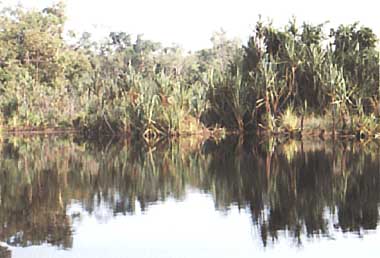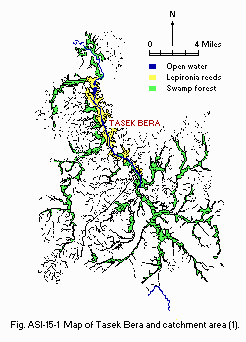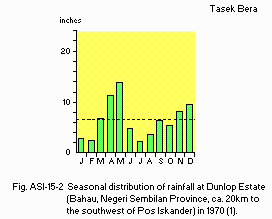TASEK BERA (SWAMP LAKE TASEK BERA)
On an open water near Pos lskander
Photo: T. kira
A. LOCATION
- Pahang State, Malaysia.
- 3:05N, 102:38E; >30 m above sea level.
B. DESCRIPTION
-
Tasek Bera is an alluvial blackwater swamp lake located in the southern part of Malay Peninsula at uppermost reach of the southern branch of River Pahang. It occupies an area of about 25 km x 35 km on the forest-covered peneplain that stretches over the low east-west watershed of the peninsula. A narrow channel drains its water northward to River Pahang and eventually eastward into South China Sea.
The lake is a complex dendritic system consisting of extensive swamp forests that account for nearly two-thirds of its area, littoral swamps overgrown by Pandanus shrub or sedges (mostly Lepironia), network of flowing channels and scattered small open waters. The open water area constitutes less than 1.5% of the whole system. The water is poor in calcium and magnesium contents, and is acidic and brown-colored due to dissolved humic substances. The decomposition of plant detritus is thus remarkably inhibited resulting in the accumulation of peat several meters thick on the lake bottom. The vigorous growth of insectivorous Utricularia in open waters and the occurrence of the other insectivores, Nepenthes spp., along the lake shore suggest oligotrophic nature of the habitats. However, the nitrogen and phosphorus contents of lake water and the biological productivity are not very low.
The catchment area has been inhabited for centuries by a Malayan aboriginal tribe, Semalai. Their subsistence depended on the shifting cultivation of upland rice and cassava, fishery in the lake and gathering forest and swamp products. The slash.and-burn agriculture has turned an extensive area of original vegetation of mixed rain forest into low secondary forest in the northern half of the catchment. In recent years, they were given a chance to go beyond their traditional subsistence economy by growing rubber trees and wetland rice, which may gradually affect the lake environment.
An integrated ecosystem research on Tasek Bera was carried out during 1970- 1974 at Pos (Fort) Iskander, within the framework of the International Biological Program by the Joint Malaysian-Japanese Team of 19 scientists. The program contributed much to the knowledge of the swamp ecosystem of this type, which once widely occurred throughout the lowlands of equatorial Southeast Asia but has almost disappeared. As its valuable relics that escaped exploitation, it is desirable to preserve the peculiar biota and natural physiognomy of Tasek Bera as a nature reserve (Editor).
C. PHYSICAL DIMENSIONS (1)
| Surface area [km2] | 62 |
| Maximum depth [m] | 7 |
| Mean depth [m] | 2-2.5 |
| Water level | Unregulated |
| Normal range of annual water | |
| - level fluctuation [m] | 1-5 |
| Catchment area [km2] | ca. 550 |
D. PHYSIOGRAPHIC FEATURES
D1 GEOGRAPHICAL- Sketch map: Fig. ASI-15-01.
- Number of outflowing rivers and channels (name): 1 (Sungai (River) Bera).
- Climatic data at Pos Iskander
| Jan | Feb | Mar | Apr | May | Jun | Jul | Aug | Sep | Oct | Nov | Dec | Ann. | |
|---|---|---|---|---|---|---|---|---|---|---|---|---|---|
| Mean temp. [deg C]*1 | 24.6 | 26.2 | 27.1 | 26.4 | 27.5 | 27.4 | 27.4 | 25.8 | 25.3 | 28.3 | 24.0 | 23.9 | 26.2 |
| Precipitation [mm]*2 | - | - | - | - | - | - | - | - | - | - | - | - | 2,522 |
- Solar radiation (June 1972-March 1973): 13.6 MJ m-2 day-1 (1).

Map of the lake and catchment area (1).

Seasonal distribution of rainfall at Dunlop Estate (Bahau, Negeri Sembilan Province, ca. 20 km to the southwest of Pos Iskander) in 1970 (1).
- Water temperature [deg C](2)
| Pos Iskander*1, 1971 | ||||||||||||
| Depth [m] | Jan | Feb | Mar | Apr | May | Jun | Jul | Aug | Sep | Oct | Nov | Dec |
|---|---|---|---|---|---|---|---|---|---|---|---|---|
| 0*2 | 23.9 | 24.5 | 25.5 | 26.7 | 25.9 | 25.9 | 26.6 | 26.6 | 25.7 | 26.3 | 25.8 | 24.1 |
| 1 | 23.8 | 24.4 | 25.3 | 26.0 | 25.7 | 21.7 | 25.8 | 25.5 | 25.2 | 26.3 | 25.1 | 24.1 |
| 2 | 23.7 | 24.4 | 25.3 | 25.9 | 25.7 | 25.6 | 25.6 | 25.3 | 25.5 | 26.2 | 25.0 | 24.1 |
| 3 | 23.7 | 24.3 | 25.2 | - | - | - | - | - | - | - | 25.0 | 24.1 |
| 4.5*3 | 23.6 | - | - | - | - | - | - | - | - | - | - | - |
- Freezing period: None.
- Mixing type: Polymictic.
E. LAKE WATER QUALITY
E1 TRANSPARENCY [m](2)
| Pos Iskander*, 1971 | ||||||||||||
| Depth [m] | Jan | Feb | Mar | Apr | May | Jun | Jul | Aug | Sep | Oct | Nov | Dec |
|---|---|---|---|---|---|---|---|---|---|---|---|---|
| 1.2 | 1.5 | 1.6 | 1.7 | 2.0 | 1.9 | 2.1 | 1.8 | 2.7 | 2.5 | 2.2 | 2.1 | |
| Pos Iskander*, 1971 | ||||||||||||
| Depth [m] | Jan | Feb | Mar | Apr | May | Jun | Jul | Aug | Sep | Oct | Nov | Dec |
|---|---|---|---|---|---|---|---|---|---|---|---|---|
| 0 | 4.8 | 4.9 | 4.7 | 5.0 | 4.9 | 5.0 | 5.1 | 5.0 | 4.7 | 4.8 | 4.8 | 4.8 |
| 1 | - | 4.9 | 4.7 | 5.0 | 4.8 | 5.0 | 5.1 | 5.1 | 4.8 | 4.9 | 4.9 | 4.8 |
| 2 | - | 4.9 | 4.7 | 5.0 | 4.8 | 5.0 | 5.1 | 5.0 | 4.8 | 4.9 | 4.8 | 4.8 |
| 3 | - | 4.9 | 4.8 | - | - | - | - | - | - | - | 4.8 | 4.8 |
| Pos Iskander*, 1971 | ||||||||||||
| Depth [m] | Jan | Feb | Mar | Apr | May | Jun | Jul | Aug | Sep | Oct | Nov | Dec |
|---|---|---|---|---|---|---|---|---|---|---|---|---|
| 0 | 1.36 | 1.46 | 1.41 | 1.31 | 1.49 | 2.21 | 2.58 | 2.96 | 2.29 | 2.70 | 2.61 | 1.80 |
| 1 | 1.10 | 1.50 | 1.52 | 1.31 | 1.83 | 2.04 | 2.41 | 2.68 | 2.48 | 2.02 | 2.23 | 1.75 |
| 2 | 1.08 | 1.45 | 1.64 | 1.22 | 1.88 | 1.81 | 2.16 | 2.41 | 2.26 | 2.11 | 2.07 | 1.62 |
| 3 | 1.03 | 0.93 | 1.46 | - | - | - | - | - | - | - | 2.41 | 1.78 |
| 4.5 | 0.95 | - | - | - | - | - | - | - | - | - | - | - |
-
September-October 1973
- Open and forest-covered waters: 1.32 (0.70-1.94).
E7 NITROGEN CONCENTRATION [mg l-1](1)
-
Pos Iskander*, 1970-1972
- Total-N: 1.12 (0.50-2.38).
- NO3-N: 0.11 (0.02-0.29).
- NO2-N: 0.008 (0.000-0.059).
- NH4-N: 0.33 (0.00-0.77).
- Organic N: 0.58 (0.06-1.53).
* Open water.
- PO4-P [mg l-1]
Pos Iskander* 1970-1972: 0.021 (0.00-0.065). Nearly depleted in summer and fall. The ratio of reactive to unreactive phosphorus: 1/21 on an average. * Open water.
F. BIOLOGICAL FEATURES (1)
F1 FLORA- Emerged macrophytes
Pandanus helicopus, Lepironia articulata, Eleocharis ochrostachys. - Floating macrophytes: Nymphoides indica.
- Submerged macrophytes: Utricularia flexuosa, Cryptocoryne griffithii.
- Phytoplankton
Diatoms (Tabellaria fenestrata, Eunotia gracilis, E. lunaris, E. robusta, Frustulia rhomboides, Pinnularia major); desmids (Cosmarium moniliforme, Closterium dianae, C. gracile, C. libellula, Hyalotheca dissiliens, H. undulata, Micrasterias foliacea). - Epiphytic algae
Diatoms (Frustulia rhomboides var. saxonica, Eunotia naegelii); green algae (Bulbochaete praereticulata, Closterium spp., Xanthidium spp., Stautrastrum spp., Desmidium spp.); blue-green (Stigonema panniforme, Hapalosiphon stuhlmanni).
- Zooplankton
Cladocera (Alona affinis, A. guttata, Chydorus spp., Macrothrix spinosa); Rotifera (Euchlanis dilatata, Colurella colurus, Keratella cochlearis); Protozoa (Euglypha brachiata, Difflugia spp., Arcella spp., Centropyxis aculeata). - Benthos*
chironomids, Cladocera, Ostracoda, Ephemeroptera, Macrobrachium trompi, Caridina thambipillai; (Bottom) larvae of Diptera (chironomids), Ephemeroptera, Trichoptera and Odonata; Custacea (Decapoda), Oligochaera, Nematoda. * In Utricularia community. - Fish
Notopterus notopterus, Oxygaster oxygastroides, Rasbora dorsicellata, Cyclocheilichthys apogon, Puntius tetrazona, P. fasciatus, Kryptopterus bicirrhis, Pristolepis fasciatus, Nandus nebulosus, Betta pugnax, Labiobarbus faestiva, Tor clouremis, Botia hymenophysa, Kryptopterus limpok. * Relatively abundant near Pos Iskander. - Supplementary notes on the biota
The great abundance and diversity of desmids, which includes several taxa endemic to Tasek Bera, is a striking feature of the algal flora of the lake. Ninety-five species of fish have so far been recorded from Tasek Bera. Almost all the species seem to be indigenous to Peninsular Malaysia.
- Phytoplankton production
| Pos Iskander, 1973 | ||
| Open water (still) | Flowing channel | |
|---|---|---|
| Net production [mg C l-1 day-1] | 0.02-0.07 | 0.01 |
| Dark respiration [mgO2 l-1 day-1] | 0.08-0.75 | 0.12-0.64 |
| Gross production [mg C l-1 day-1] | 0.07-0.25 | 0.19 |
- Submerged macrophyte production [g (dry wt.) m-2 day-1]
Net production rate: Utricularia flexuosa 12; Cryptocoryne griffithii 5. - Emerged macrophyte production (Lepironia articulata)[g (dry wt.) m-2 day-1]
Net production rate 2.24; dark respiration rate 2.65; gross production rate 4.89.
| Open | Utricularia | Lepironia | Swamp | |
|---|---|---|---|---|
| Average biomass | water | mat | zone | forest |
| Phytoplankton [cell no. l-1] | 198 | 440 | - | 124 |
| Utricularia flexuosa [g (dry wt.) m-2] | - | 105 | - | - |
| Cryptocoryne griffithii [m-2] | 0.9 | - | - | 19.9 |
| Lepironia articulata [m-2] | - | - | 477 | - |
| Shrimp (Macrobrachium & Caridina) [m-2] | - | 1.5 | - | - |
G. SOCIO-ECONOMIC CONDITIONS
G1 LAND USE IN THE CATCHMENT AREA (1)
| 1970 s | ||
| Area [km2] | [%] | |
|---|---|---|
| Natural landscape | ||
| - Upland forest vegetation | ca. 550 | 90 |
| - Swamp | 61 | 10 |
| - Open water | 0.75 | 0.1 |
| Others | - | |
| Total | 614 | 100 |
- Main types of upland forest
Lowland rain forest (mixed Shorea-Dipterocarpus forest), secondary forest (produced by shifting cultivation and logging). - Main types of swamp vegetation
Tall swamp forest (Eugenia, Elaeocarpus, Alstonia, etc.), Pandanus helicopus thicket, reed (Lepironia articulata) swamp. - Main kinds of crops and cropping systems
Shifting cultivation (upland rice, cassava, etc.), rubber plantation. - Levels of fertilizer application on crop fields: None.
- Trends of change in land use
Beside the traditional shifting cultivation by native inhabitants, rubber plantation and wet paddy cultivation were recently introduced on a small scale. The watershed forests have been cut for commercial timber since 1975, mostly from near the swamp.
| l970's | |||
| Population* | Population density [km-2] | Major cities (population) | |
|---|---|---|---|
| Urban | - | - | None |
| Rural | ca. 700 | - | |
| Total | ca. 700 | 1.3 | |
H. LAKE UTILIZATION
H1 LAKE UTILIZATION
-
Fisheries and navigation.
I. DETERIORATION OF LAKE ENVIRONMENTS AND HAZARDS
I1 ENHANCED SILTATION- Extent of damage: Not serious.
I2 TOXIC CONTAMINATION
- Present status: No information.
I4 ACIDIFICATION
- Extent of damage: No information.
J. WASTEWATER TREATMENTS
J1 GENERATION OF POLLUTANTS IN THE CATCHMENT AREA-
a) Pristine lake environments.
N. SOURCES OF DATA
- Furtado, J. I. & Mori, S. (ed.)(1982) Tasek Bera - the Ecology of a Freshwater Swamp. Dr. W. Junk Publishers, The Hague-Boston-London.
- The Malaysian IBP (PF) Subcommittee (1972) Data on Malaysian-Japanese IBP (PF) Research at Tasek Bera, Malaysia. No. 1. Kuala Lumpur (Mimeograph).


